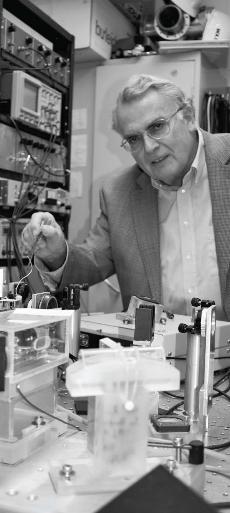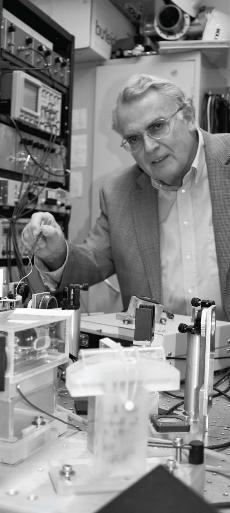
(lauren mimms)
Rachel Young: Tell me a little bit about how you got interested in physics and teaching.
John Brandenberger: All right, so I grew up in Illinois, but I went to Carleton College. I thought I would eventually be an engineer and do one of those 3-2 programs with either MIT or Columbia, and in the third year, which is supposed to be the last year before you go to the other institution for two years, I found I liked it so much that I wanted to spend my senior year there. I was majoring in physics, and I was going to go on to be an engineer. Physics is a pretty good background for most kinds of engineering, but then after finishing in physics, I decided I wanted to stay in physics, so I went to graduate school. I met a guy in graduate school at Brown University who taught at Lawrence, and we used to play tennis together. He was always telling me about how great Lawrence was. There was an opening [at Lawrence to teach] when I was finishing in 1968, and I came up, and joined the place. During the summer between my junior and senior year at Carleton, I spent a lot of time doing research, and I had wondered then what a career in a small liberal arts college would be like. To do physics there and to teach mainly physics, and try to do some research, to the degree that it would be possible, and it looked pretty good to me. In that sense, I think from early on, since I was a junior in college, really, I was thinking an academic career in a liberal arts college had a number of advantages. I realize that at this college I would get to have lunch with historians and mathematicians and Russian professors, and it’s a nice broad thing. I married a woman who is a musician, so it was natural to come to Lawrence [as well] because there were opportunities for her here. She teaches violin down in the arts academy.
Young: As you mentioned a bit, in a liberal arts setting, you get to have lots of different types of students in your classes, and maybe physics isn’t always their strength. How do you deal with students who aren’t very excited about physics, and make the subject relatable to everyone?
Brandenberger: Right, so, one’s approach depends on the audience. For example, when I’ve taught freshman studies and we’ve had “Relativity,” or when I have non-majors in my introductory physics courses, I tend to stress conceptual physics, and hold the amount of mathematical content at a modest level. I instead try to reinforce the physical, the physical thinking, physical argument, waving one’s hands as I’m doing right now, to better understand motion, or light, or other things. I think that works pretty well for me, to stress the conceptual things. When I teach, I call on students quite a bit, and initially, that puts them off, puts them on edge, but after awhile they get used to it, and I think they realize that by my calling on them I figure out what they have learned and what they understand. When they can’t answer … I realize I need to go over it again, so through my questioning, we achieve a certain amount of drill that I think sometimes helps, especially the non-physics student, assimilate the material.
Young: What are you teaching currently?
Brandenberger: So I am retired, well, I was supposed to have retired two years ago, but the agreement is that I would have this very small office, and keep my laboratory, because there’s quite a bit of equipment around here that I developed, that I can service and keep running, and that my colleagues who are interested in other things would have more trouble with. [Currently] we have a plan that I’ll be here for three years, and I’m supposed to help students keep some of the equipment going. But then, I also became interested in innovation, and so I approached Adam Galambos in the economics department. We decided to launch a team-taught course, and we call it “In Pursuit of Innovation.” To highly exaggerate our objective [with that course], we’re going to save the country. We’re sort of working on saving the country because many experts believe that the United States is becoming less and less competitive globally, and as a result, we need to do a number of things. We need to support research, substantially improve education, K-12, or maybe K through the University, but many experts who research these problems worry and think that more innovation in the U.S., a workforce that is more innovative, a larger number of people who have a knee-jerk reaction to wanting to innovate, to change things, produce new ideas, that will produce new products, new processes. That will lead to new companies, new companies lead to the creation of jobs, and right now with 10-percent unemployment, the situation is even worse than when Galambos and I started thinking about this, so we like to think that if we can figure out how to teach students how to be innovative, and really learn how to do it, we can teach other people to teach students how to be innovative, and that maybe we could, in a modest way, have an impact on improving and sustaining the competitiveness of the U.S.
Young: When you say “innovative,” what do you mean by that?
Brandenberger: There are lots of ways you can define innovative, but the definition I like is “to apply new ideas and new approaches to the development of new products, new processes, or new ventures, that are often based on antecedents, all for the good of society.” That definition applies in many fields. You may or may not be aware that the economists here are offering other courses besides Galambos’ and my course. Other courses on innovation are trying to attract art students, music students, language students, arguing and believing that innovation in the way you, [for example] teach Chinese, in the way artists, maybe, paint or something, the way musicians approach their art, could benefit if within this institution we were to raise visibility and make the case for students striving to be more innovative, more curious. The question is will your family, your children enjoy the same standard of living that I did, or even you did? And if we don’t get this thing turned around, they could very well not, and that’s why it is so important that this physics department has taken on as a common theme the process in figuring out how to teach innovation.
Young: What do you like to do when you aren’t at Lawrence? Do you have free time?
Brandenberger: Not much free time, I’m quite a workaholic. I have electric trains at home. I was supposed to be able to retire because I have a pretty big set of electric trains – I reverted back to a childhood hobby – but that just wasn’t adequate. So, since retirement a student and I have built a physics machine, and are working on some research that will go into a publication. All of that is just too much fun, so I probably spend too much time in here [in the lab]. [What I’m doing currently is] in the center of the table, we have atoms in a container, and we bombard those poor atoms with light, and through some fairly ingenious stuff, not our thinking, we’re just copying other people, we slow those atoms down so that they’re almost stationary. When they’re stationary, they’re exceedingly cold. If you think winter in Wisconsin is cold, those atoms are at one thousandth of one degree absolute. Once you’ve gone through the trouble to cool them and trap them, now they’re sitting ducks to be manipulated and further interrogated, so that’s what we’re doing right now. It’s a means towards an end, we have yet to capitalize on the system you see here, but we will continue to badger the poor things [atoms], to pummel them, so that we can study their reaction. A lot of the lasers you see here I’ve built myself, because they’re much simpler to fix if I understand them. You’re much better if you’re control of your own destiny [when it comes to building equipment], and the students will help, and they will b
etter understand the experiment, because they helped build it themselves.

(lauren mimms)
